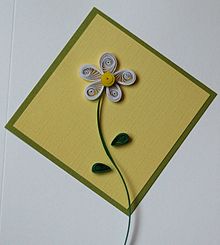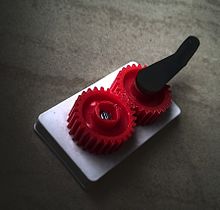Quilling
මෙම ලිපිය සිංහල බස වෙතට පරිවර්තනය කිරීම අවශ්යව ඇත. මෙම ලිපිය ලියා ඇත්තේ සිංහල භාෂාවෙන් නොවේ. මෙය අරමුණු කොට ඇත්තේ එම භාෂාව භාවිතා කරන ප්රජාව නම්, එය පැවතිය යුත්තේ එම භාෂාවෙහි විකිපීඩියාව තුළ ය. විකිපීඩියා ලැයිස්තුව වෙත යොමු වන්න. සංවාදය සඳහා සිංහලට පරිවර්තනය කලයුතු පිටු යන්නෙහි මෙම ලිපියේ නිවේශිතය වෙත යොමු වන්න. මෙම ලිපිය සිංහලයෙන් යළි නොලියැවුනේ නම් ඉදිරි සති දෙක ඇතුලත මෙය මකා දැමුම සඳහා ලැයිස්තු ගත කෙරෙනු ඇත සහ/හෝ එහි වර්තමාන භාෂාවට අදාල විකිපීඩියාව වෙතට ගෙන යනු ඇත. ඔබ විසින් මෙම ලිපිය පරිවර්තනය අවැසි යැයි මේ මොහොතේ දී නම් කළේ නම්, කරුණාකර {{subst:uw-notsinhala|1=Quilling}} ~~~~යන්න පිටුව නිර්මාණය කළ පරිශීලකයාගේ සාකච්ඡා පිටුව තුළ බහාලීමට ද කාරුණික වන්න. |


Quilling or paper filigree is an art form that involves the use of strips of paper that are rolled, shaped, and glued together to create decorative designs. The paper is rolled, looped, curled, twisted and otherwise manipulated to create shapes which make up designs to decorate greetings cards, pictures, boxes, eggs, and to make models, jewelry, mobiles etc. Quilling starts with rolling a strip of paper into a coil and then pinching the coil into shapes that can be glued together. There are advanced techniques and different sized paper that are used to create 3D miniatures, abstract art, and quilled flowers among many things.
ඉතිහාසය
[සංස්කරණය]During the Renaissance, French and Italian nuns and monks used quilling to decorate book covers and religious items. The paper most commonly used was strips of paper trimmed from the gilded edges of books. These gilded paper strips were then rolled to create the quilled shapes. Quilling often imitated the original ironwork of the day.[1]
In the 18th century, quilling became popular in Europe where gentle ladies of quality ("ladies of leisure") practiced the art. It was one of the few things ladies could do that was thought not too taxing for their minds or gentle dispositions. Quilling also spread to the Americas and there are a few examples from Colonial times.[2]
Many quilled art works can be found on cabinets and stands, cribbage boards, ladies' purses, a wide range of both pictures and frames, work baskets, tea caddies, coats of arms and wine coasters. Storage boxes, larger than most jewelry boxes with drawers and/or tops that opened, quilled lock boxes, and much more. Some items were specially designed for quilling with recessed surfaces. Quilling was also combined or married with other techniques such as embroidery and painting.[3]
Today, quilling is seeing a resurgence in popularity with quillers (people who practice the art of quilling) on every continent and in every walk of life. No longer confined to the "upper classes", this is a peoples art form and the beauty of the art is always expanding thanks to innovators and rapidly growing number of quillers. Quilling is great for all ages thanks to the simplicity of the techniques and how relaxing it is. The craft has become increasingly popular due to the low cost of the material. It is used to decorate wedding invitations, for Christmas, birth announcements, greeting cards, scrapbook pages, and boxes. Quilling can be found in art galleries in Europe and in the United States and is an art that is practiced around the world.[4] One of the most well-known quilling artists in modern times is Russian artist, Yulia Brodskaya.
Accessibility
[සංස්කරණය]Quilling is relatively easy to learn compared to most other crafts, and with the resources available today, it can be learned by almost everyone. Basic quilling techniques can be learned almost anywhere and there are several videos online that can teach you how to start quilling.[5] There are more exotic styles of quilling that aren't commonly taught, but can be learned through books that teach the specific style you are looking for.[6] Quilling is also a great craft for kids as it teaches them fine motor skills and is a great craft to train their hand-eye coordination. To see quilling used in the classroom, you can contact your child's school district.
මෙවලම්
[සංස්කරණය]Slotted tool
[සංස්කරණය]
The slotted tool is the most important quilling tool as it makes curling coils much easier and faster. The quality of the coil is noticeably higher compared to a coil that was curled with a toothpick or hand. For younger children, it is recommended that a Curling Coach be used with the slotted tool.
Needle tool
[සංස්කරණය]The needle tool plays a supporting role in the craft. It is used primarily to apply glue to hard-to-reach areas of the coil or quilling design.
Tweezers
[සංස්කරණය]
Tweezers are used to handle delicate coils to prevent warping and unraveling. They keep the coils the same size which is important when making something with duplicate coils, like flower petals. Tweezers are also helpful in inserting paper in tight spaces.
රවුම් ප්රමාණයේ පාලකය
[සංස්කරණය]කරකැවීමෙන් පසු අවශ්ය ප්රමාණයට දඟර සෑදීමේදී රවුම් ප්රමාණයේ පාලකය අත්යවශ්ය වේ. පැත්තේ ඇති පාලකය කර්ලින් කිරීමට පෙර එකම දිග බව සහතික කිරීම සඳහා එක් එක් තීරුව මැනීමට භාවිතා කරයි.
Curling coach
[සංස්කරණය]Curling coaches make a great compliment tool for slotted tools and are recommended for younger kids and for people who like to quill 3D miniatures. It makes curling the strips much faster and easier than if they were curled with just the slotted tool.
Crimper tool
[සංස්කරණය]
This tool is used to make crimped quilling strips. It helps to create different patterns.
Paper types
[සංස්කරණය]Quilling paper is available on the consumer market in over 250 colors and dimensions. It can be divided into various categories, like solid colored Quilling paper, graduated Quilling paper, two-tone Quilling paper, acid free Quilling paper and other assorted parcels of Quilling paper. It is available in various dimensions, such as 1/8”, ¼” and 3/8 broad paper parcels.[7]
නමේ පැහැදිලිව පෙනෙන පරිදි මෙය සම්පූර්ණයෙන්ම ඇසිඩ් රහිත කඩදාසියකි. සීරීම් පොත් සෑදීම, රබර් මුද්රා තැබීම සහ පින්තූර සඳහා රාමු නිර්මාණය කිරීම සඳහා ගුණාත්මකභාවය එය විශිෂ්ට තේරීමක් කරයි. රාමු කළ පින්තූරයට හෝ ඇල්බමයට කිසිදු අතුරු ආබාධයකින් තොරව ඔබේ ව්යාපෘතිය ජීවිත කාලය පුරාම පවතිනු ඇති බවට එය සහතික කරයි.
This type of paper provides an exceptional look to decorative quilling projects. The edges have a solid color that gradually fades to white. When using a graduated paper, a quilling ring begins with a dark shade but ends up being faded to a lighter side. On the contrary, some graduated papers begin as white, or a lighter shade, and then slowly fades into a solid, darker color.
This is another important type of quilling paper. It is quite similar to the graduated quilling paper in its use. The look consists of a concrete color on one side and comparatively lighter color on the other side. With two-tone paper the color remains same, however the intensity of color is different. The main use of this quilling paper is to provide a desired level of softness to the quilled subject. It possesses the capacity to quill many papers in a single spiral.
තවදුරටත් කියවීම
[සංස්කරණය]- Papp, Melinda Florian; Papp, William James, Rolled, Scrolled, Crimped, and Folded: The Lost art of Filigree Paperwork, New York: Florian Papp, OCLC 473586647 - 50 pages of information and pictures of antique works of art.
යොමු කිරීම්
[සංස්කරණය]- ^ "The History of Quilling".
- ^ Finding antique quilling.
- ^ "Quilling paper and book art".
- ^ Alli Bartkowski (2005).
- ^ Art and Craft:Basic quilling shapes for beginners, Simple Quilling Ideas
- ^ "Quilling Books from Quilled Creations". www.quilledcreations.com.
- ^ Alli Bartkowski (2005).
